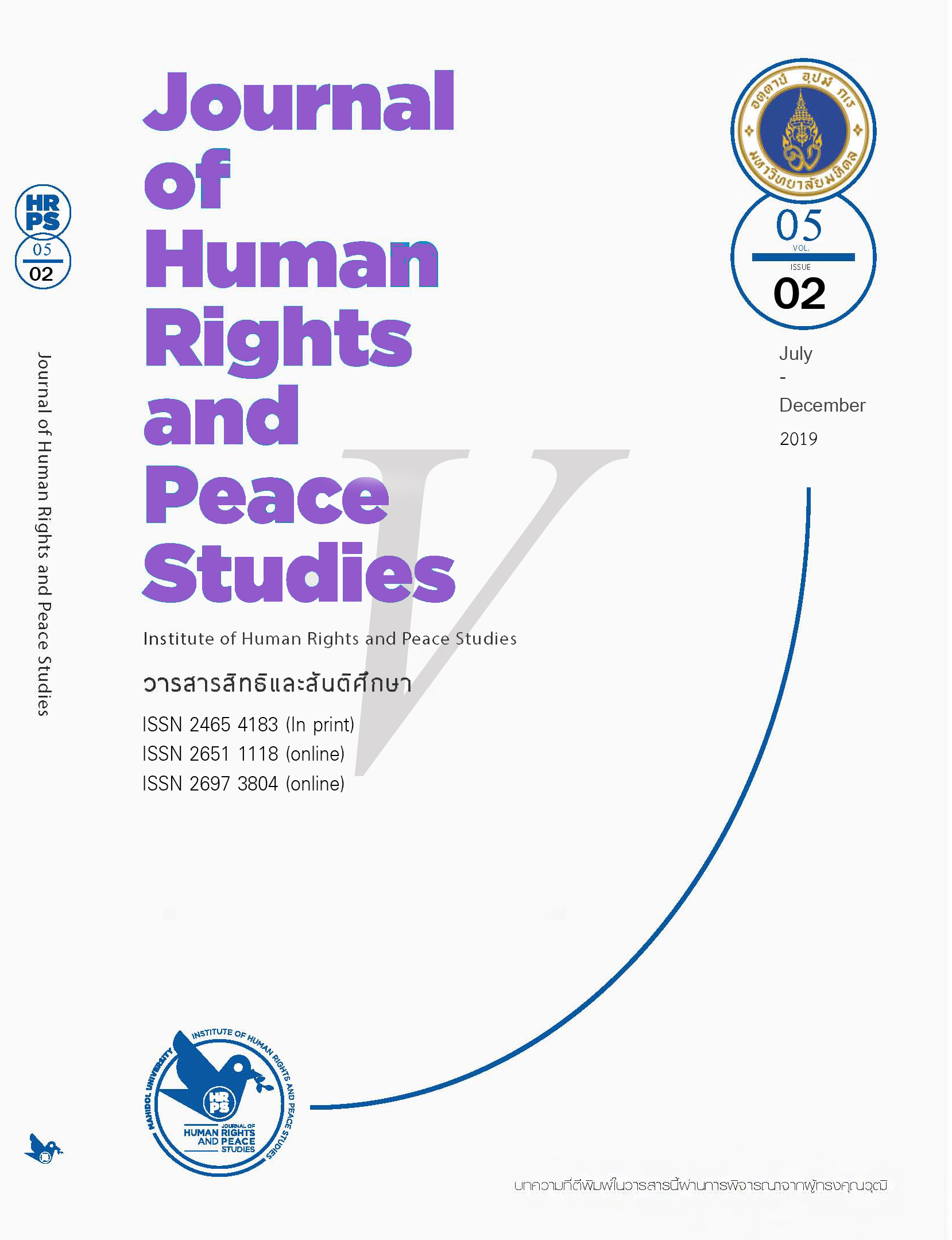Monasteries The Places of Reproduction of Violence in The Name of Compassion
Main Article Content
Abstract
Buddhist monasteries have been claimed as peaceful places and monks do not support the violent approaches. These claims are falsified by this research, which focuses on the violence in Buddhist temples, where monks treat novices cruelly, in many cases. Two questions are raised namely; how has Theravada Buddhism interpreted to serve the violence? And what kind of violence can be found in the monasteries nowadays? Ethnographical methodology was conducted in many provinces of Southern Thailand. The researcher, as a monk, has been staying with those novices for 18 years. It finds that Thai Buddhism is interpreted as utilitarianism to serve the dictator monks who take care of novices. Many kinds of violence such as verbal, physical, and sexual harassments can be done in the name of the compassionate protectors who punish for the success of his pupils. Though many abbots are compassionate, they are too old to take care of young novices. The power is, in fact, used by secretary monks who have responsibility in educating novices. In consequence, abbots cannot help when novices are harassed. This phenomenon clearly reveals the failure of gerontocracy in Thai monastic administration. At the same time, many novices still choose to live in the temples because their families are also in the problems. Violence in religious area is always ignored, while its intensity is not less than the worldly sphere.
Article Details

This work is licensed under a Creative Commons Attribution-NonCommercial-NoDerivatives 4.0 International License.
The views, opinions, and pictures expressed in this journal are those of the authors and do not necessarily reflect the opinions and viewpoints of the editor and the editorial board. All rights are reserved by the authors and the Institute of Human Rights and Peace Studies of Mahidol University. No part of this journal may be reproduced, stored in a retrieval system, or transmitted in any form or by any means without the prior permission in writing from the journal’s editor, or as expressly permitted by law, or under terms agreed with the appropriate reprographics rights organization. Non-commercial use of information in this journal must be properly referenced.
References
Barakun, B. (1999). Revealing the process of destroying Buddhism. Bangkok: Siam Business and Printing. (In Thai).
Biver, E. (2014). Religious nationalism: Myanmar and the role of Buddhism in anti-Muslim narratives. An analysis of Myanmar’s ethnic conflicts through the lens of Buddhist nationalism. Master of Science in Global Studies, Department of Political Science.
Brooten, L. (2015). Blind Spots in Human Rights Coverage: Framing Violence Against the Rohingya in Myanmar/Burma. Popular Communication (13)2: 132-144.
Bunnag Jane. (2007). Buddhist monk, Buddhist layman: A study of urban monastic organization in central Thailand. NY: Cambridge University Press.
Chaiwat Satha-Anand. (1987). Islam and violence: A case study of violent events in the Four Southern Provinces, Thailand, 1976-1981. Tampa, FL: Department of Religious Studies, University of South Florida.
Chinnaworn Thirabhaddo. (2017). The Monks’s Role towards Reducing Conflicts according to the Buddhist Way. .Jounal of Graduate Study Review Nakhonsawan Buddhist Collage, 2(1).(In Thai).
DeVotta, N. (2007). Sinhalese Buddhist nationalist ideology: Implications for politics and conflict resolution in Sri Lanka. Policy Studies (40): I-104
Gravers, M. (2015). Anti-Muslim Buddhist nationalism in Burma and Sri Lanka: Religious violence and globalized imaginaries of endangered identities. Contemporary Buddhism, 16(1): 1-27.
Gross, R. (1993). Buddhism after Patriarchy: A Feminist History Analysis and Reconstruction of Buddhism.The United States of America.State University of New York Press.
Hansa Dhammahaso. (2016). Peace Study: The Buddhist Approach to the World Peace. Journal of MCU Peace Studies, 4(Special),1-9. (In Thai).
Juergensmeyer, M. (2017).Terror in the mind of God: The global rise of religious violence. (Vol. 13).Univ of California Press.
Jerryson, M. (2011).Buddhist fury: Religion and violence in southern Thailand. Oxford University Press on Demand.
Jory, P. (2002). The VessantaraJataka, Barami, and the Bodhisatta-kings: The origin and spread of a Thai concept of power. Crossroads: An Interdisciplinary Journal of Southeast Asian Studies, 16(2), 36-78.
Khasod Newspaper. (2018). “ToeSillyful” Protest the Blind point of those who worship statues! No one has rights to criticize others. Published on 4 April 2018, accessed on4 August2018 fromhttps://www.khaosod.co.th/monitor-news/news_924341 (In Thai).
Kritsada Thaworn. (2016). The Peace Strengthening Role of Dr. Ambedker according to the Buddhist Peaceful Means.Journal of MCU Peace Studies, 4(Special), 209-219. (In Thai).
Kyaw, N. (2015). Alienation, Discrimination, and Securitization: Legal personhood and cultural personhood of Muslims in Myanmar. The Review of Faith & International Affairs, 13(4), 50-59.
Narongrit Arayachaikul. (2016). The Way of Peace Building of Nelson Mandela according to Buddhist Peaceful Means. Journal of MCU Peace Studies 4(Special), 234-242. (In Thai).
Phra Dhammapitaka (P.A. Payutto). (1999). The Case of Dhammakaya: Lesson for Learning Buddhism and Develop Thai Society. Bangkok: Phim-amphai. (In Thai).
Samak Kosem. (2017). Pondan under the Pondok: Reflexive Ethnography of “Queer Muslim” and Childhood Memories in the Religious School. The Thammasat Journal of History, 4(1).161-206. (In Thai).
Schissler, M, Walton, M, &Thi, P. (2017).Reconciling contradictions: Buddhist-Muslim violence, narrative making and memory in Myanmar. Journal of Contemporary Asia, 47(3), 376-395.
Somporng Talaputto. (2018). Interviewed by TV Channel 3 “Hon Krasae” on 21 June2018, accessed on 22 July 2018 fromhttps:/youtu.be/E_N2BPCC8_0 (In Thai).
Spencer, J. (1990). Collective violence and everyday practice in Sri Lanka.Modern Asian Studies (24)3: 603-623.
Sripana Srichir. (2017). The Conceptss and Methods of Management of Conflicts according to Buddhism.Jounal of Graduate Study Review Nakhonsawan Buddhist Collage, 4(2). (In Thai).
Stanford Encyclopedia of Philosophy Archive. (2015). Social Minimum. Retrieved on 28 February 2019 from website https://plato.stanford.edu/archives/win2015/entries/ social-minimun/
Suwanna Satha-anand. (2012). Question of Violence in Thai Buddhism, in Tikhonov, Vladimir, and TorkelBrekke, (eds.) Buddhism and Violence: Militarism and Buddhism in Modern Asia. Routledge, 175-193
Zin, M. (2015).Anti-Muslim Violence in Burma: Why Now? Social Research: An International Quarterly, 82(2), 375-397.


